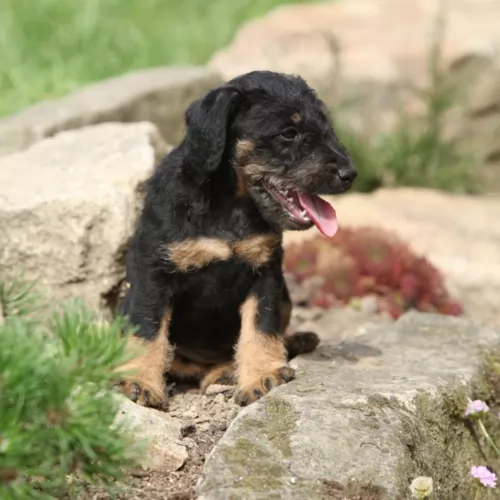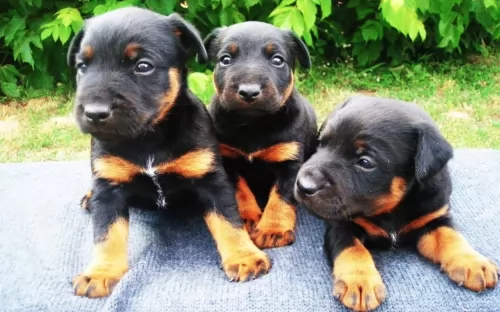 Petzlover
PetzloverDogo Cubano is originated from Cuba but Jagdterrier is originated from Germany. Dogo Cubano may grow 15 cm / 6 inches higher than Jagdterrier. Dogo Cubano may weigh 36 kg / 80 pounds more than Jagdterrier. Dogo Cubano may live 5 years less than Jagdterrier. Dogo Cubano may have more litter size than Jagdterrier. Dogo Cubano requires Low Maintenance. But Jagdterrier requires Moderate Maintenance
The Cuban Mastiff which came from Cuba, was developed from breeds of Mastiffs, Bulldogs and cattle dogs, with the breed being thought to be extinct since the end of the 19th century.
The Dogo Cubano had a number of roles to fulfill in its day and they were used for guarding stock, for dog fighting and for chasing runaway slaves. After the abolishment of slavery, the large dog had no real role and it died out.
Known also as the Cuban Mastiff or Mastin de Cuba, there isn’t much accuracy as to its origins, with the most common story for their origin being that they are descendants of the Molossus.
The dogs were later introduced into Western Europe, becoming fairly common in England and Spain. The dog was also was also mentioned in the works of canine authors Stonehenge and George Wood.
 Known as the German Hunt Terrier, the Jagdterrier hails from Germany and is a working terrier. In fact, the purpose of the Jagdterrier was for breeders to come up with an improved hunting terrier.
Known as the German Hunt Terrier, the Jagdterrier hails from Germany and is a working terrier. In fact, the purpose of the Jagdterrier was for breeders to come up with an improved hunting terrier.
The dog was developed at the turn of the 20th century, so its not a particularly old breed. There were a number of breeders who broke away from the German Fox Terrier Club, dedicating themselves to creating this newer terrier.
The first Jagdterriers were created by mixing the Old English Fox Terrier with a number of Black and Tan Hunting Terriers. Other dogs used to develop the Jagdterrier were German Pinschers, Welsh Terriers and English Wirehaired Terriers.
Today he is considered a superb hunting dog.The German Hunting Terrier Club was was founded in 1926.
The Dogo Cubano was generally similar to other Mastiffs and stood at rough 48 – 55cm in height and weighing in the region of 45kg.
He was a large dog, powerfully built, muscular and strong. Images of the dog show that it had strong, straight legs with a long tapering tail and medium-sized floppy ears that were sometimes cropped upwards and close to the head.
The dog breed came in a variety of colors such as brown, tan, fawn and brindle. The muzzle was broad and short and black. The dog had pronounced jowls with its face being fairly wrinkly.
This large dog was known for being a courageous, independent and aggressive dog. He became attached to his owner, showing protective characteristics .In those days the dog would have received simple training and certainly if such a large dog still existed today, it would have to receive training and socialization as well.
The Dogo Cubano was an intelligent dog and easily trainable, requiring an owner with a firm hand. Being an aggressive breed, the dog possibly wouldn’t have been the best companion for children. He also wouldn’t have got on too well with pets in the home as he was trained to be a fighter in his day. Independent and strong-willed, the dog would not have suited a novice dog owner.
 The Jagdterrier is a tenacious hunter, taking on lots of wild creatures such as boars, badgers and even cougars.
The Jagdterrier is a tenacious hunter, taking on lots of wild creatures such as boars, badgers and even cougars.
He is of medium size standing between 33 and 40cm in height and weighing 7-10kg.
He has a coat of black and tan which can also be a dark brown shade or be a charcoal color. The Deutscher Jagdterrier is a compact, well-proportioned dog with a wedge shaped head and flat skull. The ears are set high and go up before they come down to form floppy ears. The tail has always been docked at about one third of the tail. These days it is often left long, being carried raised.
Active, athletic and alert, the Jagdterrier is also social, intelligent, strong-willed and confident. He is a serious hunter but can make an excellent pet, especially when trained and socialized.
He is energetic so he will require owners who are prepared to include him in all their activities. They are good around children, but their hunting side makes them long to be outdoors busy with exciting activities.
The Dogo Cubano was bred to be a guard dog as well as for dog fighting, but this large dog, with training and socialization, no doubt became a loyal and devoted family pet.
It was actually a social dog, being aggressive towards other dogs. He would be described as a dog better suited to a home with older children.
He was protective with his human family but not very active, being too big to be leaping around like other dog breeds. It is a pity that this large dog has disappeared as he had some good qualities.
 Your Deutscher Jagdterrier is an intelligent dog who enjoys the company of his human family, particularly when they are active and can meet his high energy needs and his desire to be busy.
Your Deutscher Jagdterrier is an intelligent dog who enjoys the company of his human family, particularly when they are active and can meet his high energy needs and his desire to be busy.
They are quite wary with strangers and this makes them alert watchdogs. They are affectionate and playful with children if the children know how to respect them. Because of their hunting skills, they can be a bit of a threat around small animals in the home.
He is a quick learner and responds well to training and socialization. He will thrive on living in the countryside, but wherever you live with your Jagdterrier, give him plenty of exercise, a warm, dry bed, good food and your love and devotion, and he'll respond by being a super pet and companion.
The Dogo Cubano was a generally healthy breed, but just like with most other dog breeds, they were also prone to some of the more common dog problems. The chances of him getting sick were slim though.
When the dog first originated, there were unlikely to have been health clearance certificates, but today, you’d want health clearances from the Orthopedic Foundation for Animals.
The reason for this is that hip dysplasia is a heritable condition, seen more often in large dogs, where the thigh bone doesn’t fit into the hip joint properly. The dog suffers with pain and discomfort and the condition can lead to lameness with the dog.
Gastric Torsion or Bloat is a life threatening condition that affects large dogs like the Dogo Cubano and those with deep chests. The stomach is distended with gas and it can twist.
The gas can’t escape and blood flow is hindered. The dog vomits, is lethargic and weak, and immediate veterinary help will be required.
 You’re not going to be taking a sick Jagdterrier to the vet often as this is generally a healthy dog breed who can reach 13, 14 or 15 years of age with good care.
You’re not going to be taking a sick Jagdterrier to the vet often as this is generally a healthy dog breed who can reach 13, 14 or 15 years of age with good care.
He may be prone to a genetic breed disorder known as Primary Lens Luxation. Sometimes people are given prescription eye drops to constrict the pupil ad help the subluxated lens from getting worse.
This is a painful hereditary condition that leads to blindness. It affects many breeds of dog, particularly terrier-type dogs.
The Dogo Cubano was a large dog, so if he did become used to living in the city, he would have adapted better to life in the country.
He wasn’t a dog requiring too much exercise but he would have needed to go for walks. They were used as guard dogs long ago, and if he had been in existence today, you wouldn’t have been able to include him in your jogging and cycling as he was a dog that could easily overheat.
Not all dogs require the same amount of food. Long ago the Dogo Cubano wouldn’t have had the same variety of dog foods available today. Maybe the dog in those days was fed the same kind of food that his owner ate.
Today, if these dogs were still around, they would require the best quality ‘large dog breed’ kibble.
The better the dog food, the more nourishing it is and the healthier the dog is. The Dog Cubano would likely have been a dog that drooled, leaving quite a bit of backwash in the water bowl, so it would have been important to wash out the drinking bowl and to regularly replace it with cool, fresh water.
 Your energetic Jagdterrier will do well on a high-quality dog food, of which there are some good ones on the market.
Your energetic Jagdterrier will do well on a high-quality dog food, of which there are some good ones on the market.
If you do buy a commercially manufactured dog food, make sure that you read the instructions on the packaging so as to adhere to portion control. You can’t afford to have your pet becoming obese as this opens up a host of problems, and it can also shorten your dog’s life-span.
If you invest in high quality kibble, try to add in some nutritious and tasty home-made food such as cooked chicken, some brown rice or pasta and some vegetables. It is always wise to add in some raw meat from time to time as this promotes good health in your dog and prevents skin allergies.
Any diet for a dog should be in keeping with his age and his energy levels. Make sure your pet has constant access to fresh, cool drinking water.
Brush your Jagdterrier’s hair twice a week. It will keep the coat in tip top condition, but it also does your pet the world of good. He loves it when you take time out to be with him and to give him some special time. Brushing him also allows you to check him over for ticks and fleas.
Other grooming aspects for your dog will be to check on his nails and to clip them when they get too long. Ears should also be checked regularly to avoid a buildup of wax and dirt and teeth should be checked as well. Dental disease can lead to a host of illnesses which can be detrimental to the heart and kidneys.
Every dog needs different forms of exercise to remain lean and healthy. Options for exercise for your Jagdterrier can be going on walks, swimming and play time in the backyard.